Have you ever landed on a B2B blog and felt instantly drowned in a sea of jargon, only to click away seconds later?
I’ve been there too…
But imagine if that content resonated with you, spoke your language, and addressed your pain points? That’s the power of effective B2B blogging. As we tread into 2023, the rules of the game are changing, and staying updated is not just an option. It’s a necessity.
Dive into this comprehensive guide, where we unpack the 12 B2B blogging best practices that promise to transform your content and captivate your readers. Let’s journey together into the future of impactful B2B blogging!
B2B Blog Best Practices To Implement In 2023
With so many techniques to promote your company, the art of writing sometimes gets overlooked. However, it’s time to take your B2B blogging seriously and make it a game-changer.
1. Set Clear Goals For Business Blogging
Clear B2B-specific goals help align your blogging strategy with your overall business goals and make sure that every piece of content serves a specific, valuable purpose and contributes to your success.
So, what are those goals?
- Generate Leads: Your B2B blog should serve as a top-of-the-funnel tool for lead generation and attract potential clients.
- Build Brand Credibility: High-quality and authoritative content builds trust and improves your position as a thought leader, making potential clients more likely to choose it over competitors.
- Establish Thought Leadership: B2B blogs target professionals and business leaders. Sharing data-driven insights and trends shows that your company is knowledgeable and stays on top of industry developments. Your B2B blog should be a go-to resource of expertise in your niche.
But it doesn’t end there. Clear goals also measure how effective your blogging efforts are, help make data-driven decisions, and optimize your strategies accordingly.
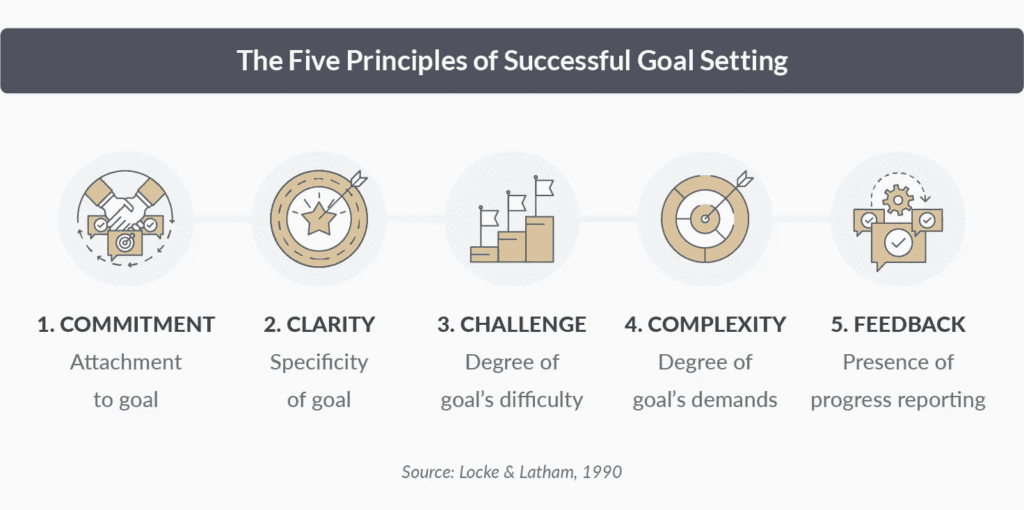
But how do you set clear goals to boost your B2B blogging efforts?
1.1. Define Specific Business Goals
This is like setting the GPS for your company’s journey. Without defining specific goals, you’re driving blind, resulting in wasted resources, missed opportunities, and even business failure.
For instance, if your B2B healthcare software company doesn’t set a clear goal like “Increase software demo sign-ups by 12% in Q3 of 2023”, chances are you won’t focus their marketing efforts effectively.
Your marketing team could end up spreading the budget across too many channels, diluting your company’s message, and ultimately failing to attract enough potential clients.
1.2. Align Goals With Your Intended Audience
Your blog content should provide value to business professionals, industry leaders, and decision-makers. Let’s say you offer cloud-based solutions for software companies and your intended audience are IT managers and CTOs looking to move their infrastructure to the cloud.
Their pain points can be concerns about data security, cost-effectiveness, or the technical aspects of migrating to the cloud. As for interest, they could be into the latest manufacturing tech trends, best practices for cloud migration, and case studies of successful transitions.
1.3. Establish Measurable Key Performance Indicators (KPIs)
Setting clear KPIs gives you a clear target to aim for. They shine a light on your performance, helping you understand what’s working, what’s not, and where you need to steer your blog.
For example one of a B2B blog’s critical KPIs is the conversion rate. This measures how many visitors perform your desired action, whether it’s subscribing to your newsletter, downloading a whitepaper, or filling out a contact form.
Last but not least, be SMART. Use the S (Specific), M (Measurable), A (Attainable), R (Relevant), and T (Time-Bound). Keep this in mind when brainstorming for your goals.
So, how does it work in action? At Novum, we work closely with clients and start the process with an onboarding call to discuss the details of the business. We ask the following:
- What are they offering?
- Who is their target audience?
- What pain points do they want us to solve?
We establish this right off the bat so we can create content that accurately reflects the brand.
After the initial meeting, we go through several phone calls with them and regularly correspond through email to make sure we are all on the same page.
2. Identify Your Target Audience
B2B blogs are not for your average Joe but for those seeking solutions to specific industry challenges or insights into industry trends. They’re the professionals, managers, executives, and businesses. So your content must resonate with their professional needs and interests, providing real value.
When you understand your readers, you can create valuable and relevant content to address their pain points, needs, interests, and search intent.
So, how do you do this? By creating buyer personas.
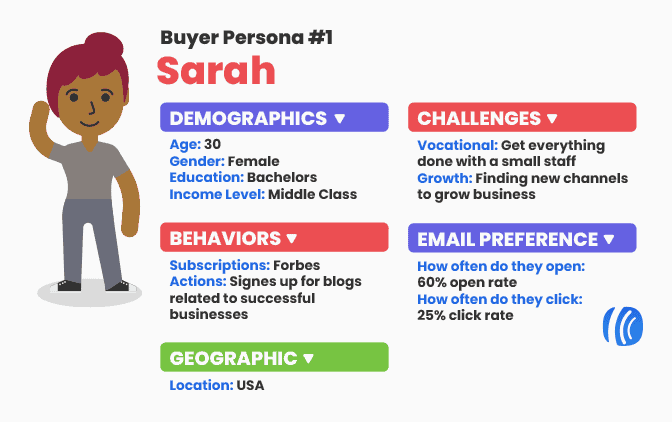
Buyer personas are fictional representations of your ideal clients, based on real data. Think of it as creating characters for your content marketing masterpiece. Determine their characteristics, such as job title, industry, challenges, and goals through conducting research, surveys, and interviews.
You’ll find that they want their B2B blogs to delve into the nitty-gritty of specific industry trends with case studies, statistics, and how-to guides. The tone is normally more professional, so share insights like the seasoned expert that you are.
With this information, you create blog content tailored to their specific needs to build a loyal readership.
3. Do Search Term Research
It’s all about doing some detective work and finding relevant golden search terms relevant to your industry. But not just any search terms. Focus on long-tail keywords. These have lower search volumes but are more specific to your niche, products, or services.
Let’s say you’re a B2B company offering supply chain management solutions. Your potential clients are likely logistics managers and operations directors looking for ways to streamline their operations or reduce costs.
You can consider highly-specific long-tail search terms, like “reduce transportation costs in the supply chain” or “real-time inventory tracking software”.
When you sprinkle those into your content and publish strategically, you’ll be on your way to climbing the search engine ranks. Ultimately, it’ll increase traffic to your site and get the conversion rate going up.
We consistently use these search term research tools for our blogs and have proven them to be effective:
- Ahrefs: Provides extensive search term data, including volume, difficulty, and related suggestions.
- Google Trends: Shows you search term popularity over time, so you can identify trending search terms.
- Google Keyword Planner: Google’s free search term research tool provides insights into search volume, competition, and search term suggestions based on your industry or website.
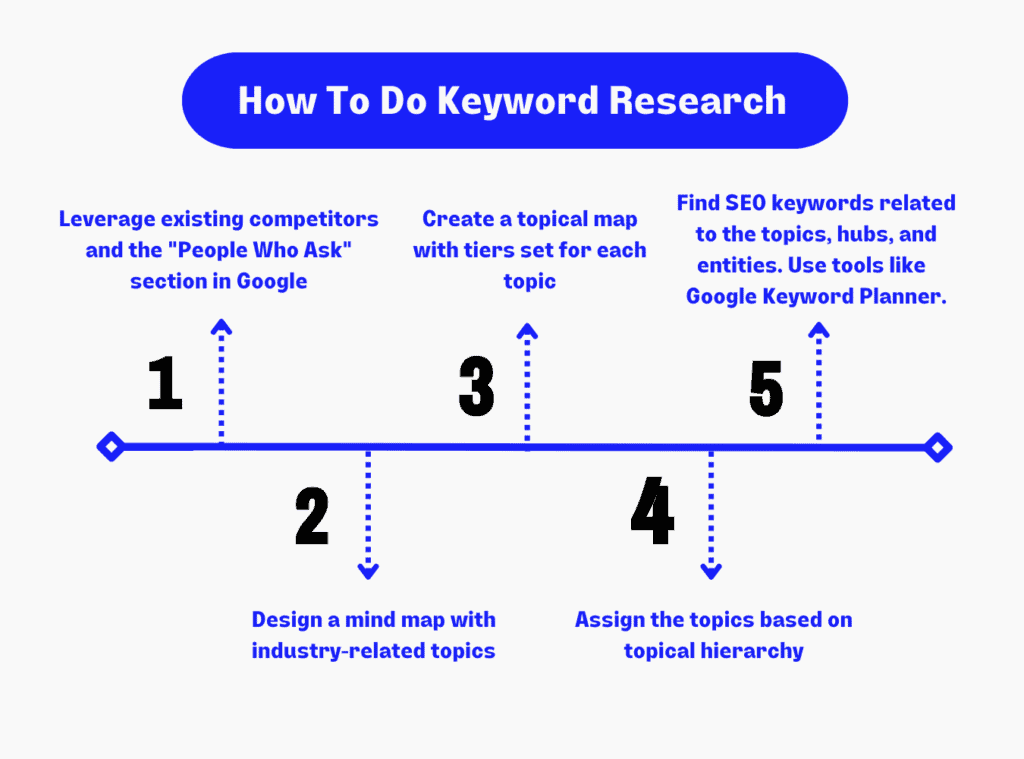
Additionally, you should leverage what search terms your existing competitors are targeting. You can also use the “People Who Ask” section on Google Search since it shows the most common queries users have regarding a specific search term, and you’ll find long-tail search terms there.
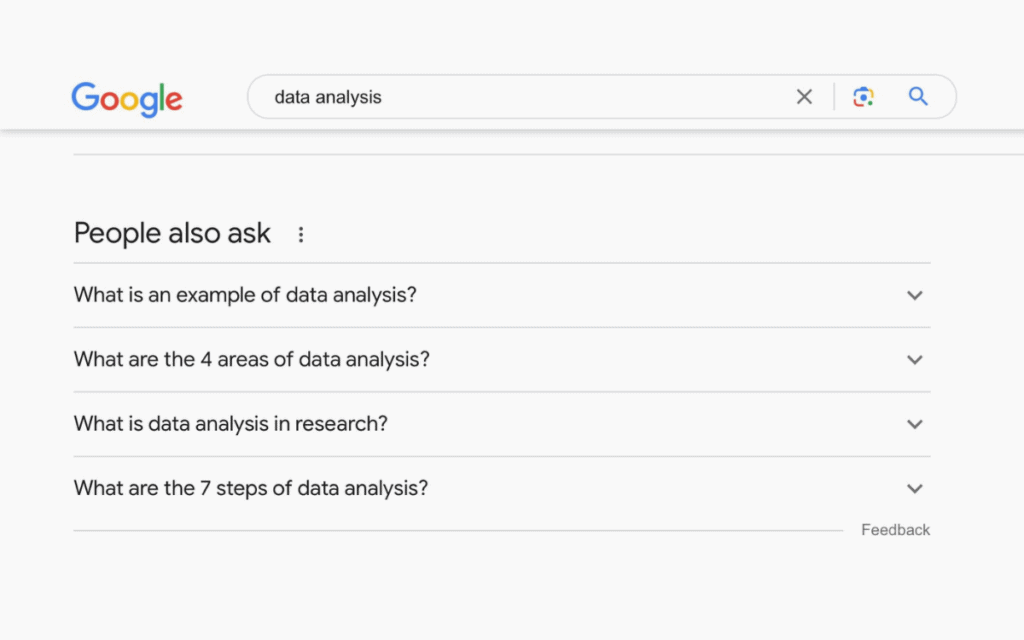
With that, you can design a mind map that includes the topics and entities relevant to your industry.
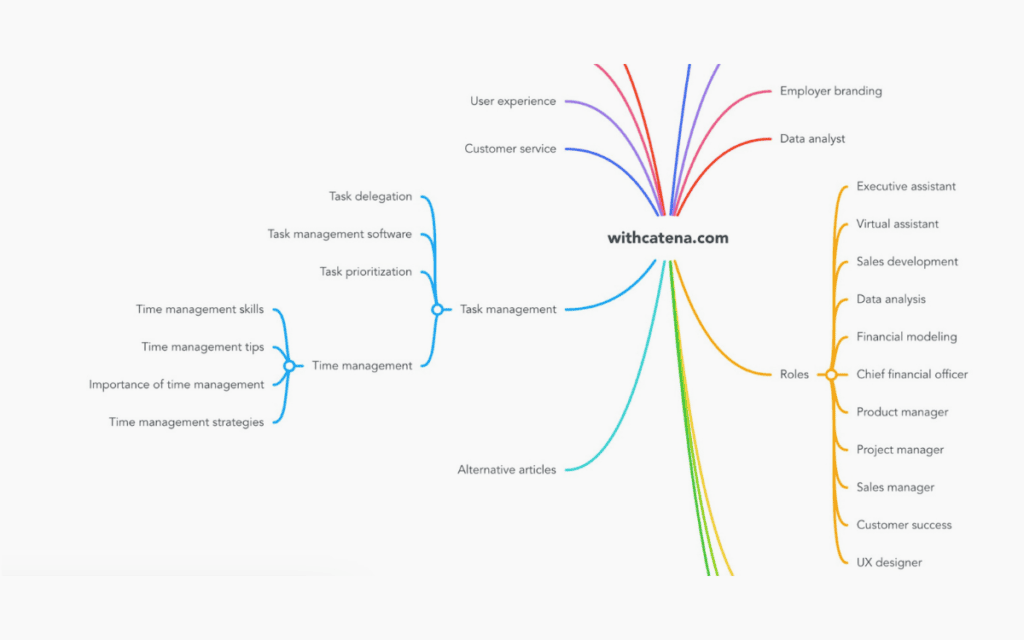
Then, comes the creation of a topical map for the client’s website. The secret to creating an effective topical map lies in setting tiers for each topic and assigning them based on topical hierarchy. This ensures you cover each topic holistically and build topical authority.
With the topical map as your guide, it’ll help you categorize and group related search terms together based on their topics or themes. This lets you see the bigger picture and the relationships between different terms.
Thus, you can identify the main topics and subtopics related to your niche and write targeted content that covers a wide range of relevant search terms. Plus, it lets you form content silos, or groups of related content that link together, boosting your internal linking structure.
Find search terms with a balance of search volume and competition. Once you have your list, strategically sprinkle them into your blog posts, headings, meta descriptions, and title tags for effective on-page SEO.
4. Write Educational & Engaging Content
When it comes to B2B blogging, the data and real-life outcomes of your products or services to clients are what matter most.
Why, you ask? Well, picture this: you’re in a noisy room filled with potential clients.
To grab their attention, you should create:
- Case studies
- Infographics
- How-to guides
- Product of service reviews
- Thought-leadership articles
- Industry trends and insights
- Interviews with industry experts
Now you know what types of content to leverage, the next question is: how do you make them engaging?
4.1. Technical Tone
This is all about precision, clarity, and detail. It’s often used in industries where complex concepts, products, or services need to be explained. It’s a language of its own, filled with industry-specific terms and a love for facts, data, and logical thinking.
Think of Intel, the tech giant. They deal with complex topics – computing solutions, and cutting-edge microprocessor technology. They use a technical tone to talk with their audience since they would likely be subject matter experts. It’s like they’re saying, “We know you get this stuff, so let’s skip the fluff and dive into the nitty-gritty of our products and innovations.”
4.2. Informative Tone
This is sharing clear, factual, and engaging information. Unlike the technical tone, this tone leverages insights and explanations to help the reader understand a topic better. Thus, the language used is straightforward, avoiding unnecessary jargon.
B2B giants like Moz use this to break down how their business solutions work, the benefits, and how they stack up against competitors. It helps them become a trusted guide in the SEO and analytics world because they’re not just sharing a product, they’re sharing valuable and applicable information.
4.3. Professional Tone
This tone exudes expertise, authority, and trustworthiness. However, strike a balance between being accessible and demonstrating a high knowledge level. Apply this when communicating with an audience that already has an understanding of a topic but needs deeper knowledge and insights.
For example, a B2B company offering AI solutions might use a professional tone to discuss the benefits of machine learning in supply chain management. They might use terms like “predictive analytics” or “data mining,” but they would make sure these terms are either commonly understood by their audience or provide context to make the meaning clear.
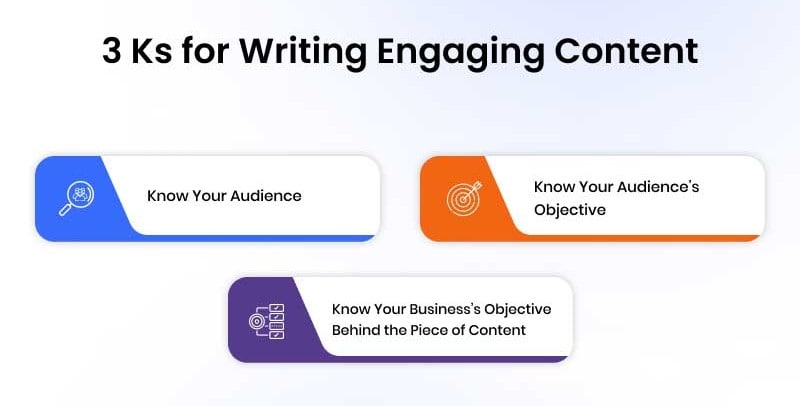
But being engaging is not enough. These professionals want to understand how your products or services will help their businesses. If not, they could be looking for a resource that gives them updates on the industry.
You can create educational content that you can repurpose as lead magnets, turning readers into believers of your brand.
So, how do you achieve this magic combo of engaging yet educational? Create data-driven online content. B2B blog readers are professionals and they’ll want accurate, credible, and well-researched content.
For instance, if you’re selling retail POS software, show them real results from clients. Include statistics on how the operations’ efficiency and sales increased. It directly addresses your audience’s needs and search intent, offering practical solutions using your products or services.
Don’t forget to add a dash of personality, storytelling, and visuals to make it entertaining and memorable.
5. Optimize Your Blog For Search Engines
Search engine optimization is the name of the game, and each blog post is an opportunity to target industry-specific search terms decision-makers are searching for.
But it’s not just about attracting traffic as much as it’s about building authority. When you share valuable case studies, data, and how-to guides, you’re showing search engines and your audience that you know your niche.
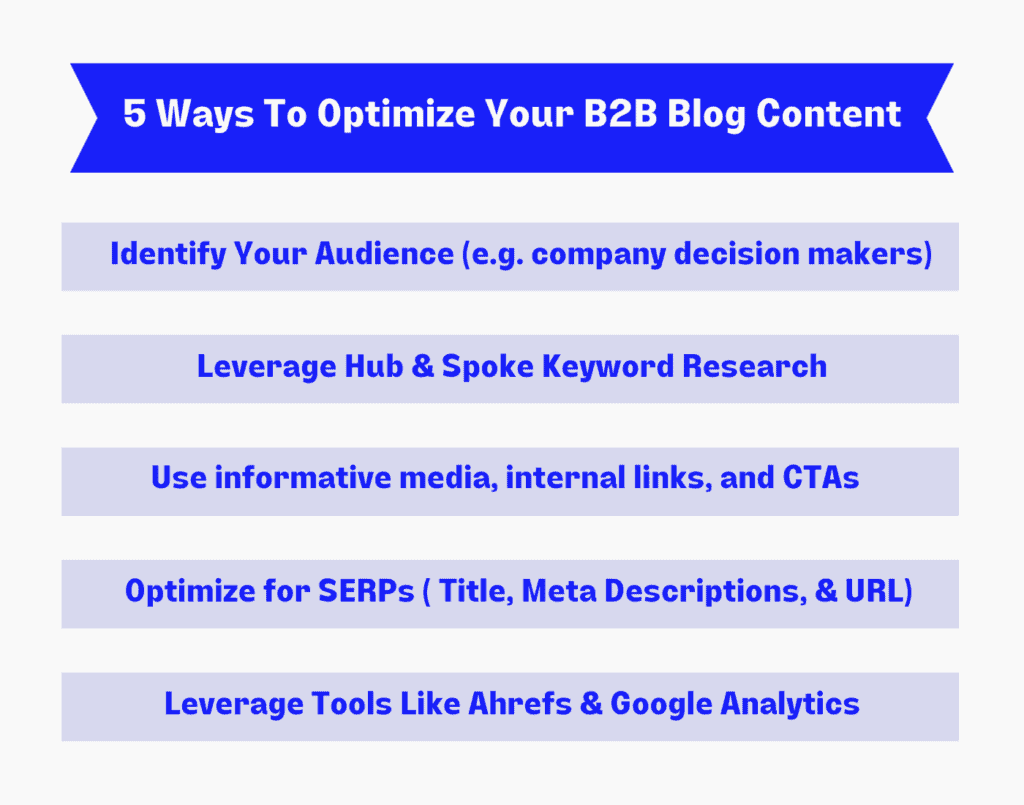
As your blog posts rank better, your audience can find you faster. This attracts more qualified leads.
Next, focus on the technical aspects of SEO. Write descriptive URLs that include the target search term and hyphens for clarity.
Here’s an example: 11+ Best Link-Building Services To 10X Your SEO Traffic
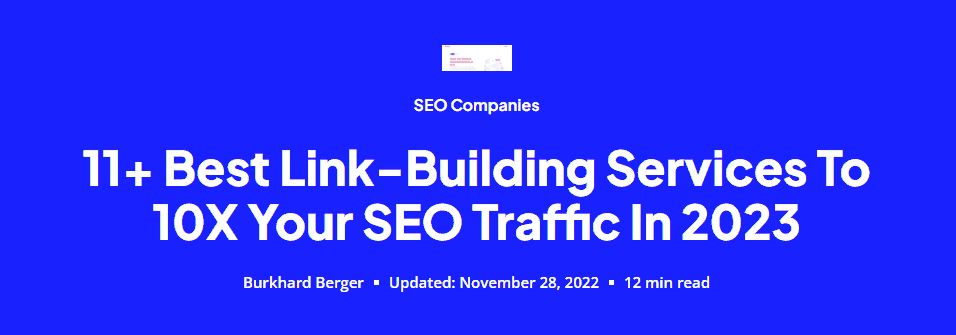
The URL indicates the content of the page and includes the search term.
Moreover, incorporate relevant internal links within your posts to guide users to related content on your website. This not only improves user experience but also helps search engines understand your content’s relevance.
Optimize your images with descriptive alt text that includes the main search term so search engines understand what the image is about.
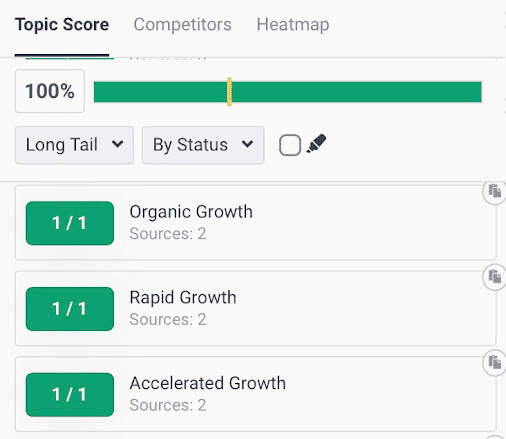
Another way to optimize blog posts for relevant search terms is to make sure to leverage on-page optimization tools to A-grade your B2B online content.
Now, what role does A+ content have?

Apply this for both new and old content.
6. Stay Updated With Industry News
Being in the know allows you to publish timely, relevant, and valuable content that speaks directly to decision-makers. When you’re up-to-date with your industry, your articles are fresher and packed with insights that make your readers go, “Wow, this brand gets it!”
Plus, staying updated helps you spot emerging trends and opportunities. In the B2B world, where the journey from reader to client is more of a marathon than a sprint, that’s crucial. It means you can keep serving up fresh, relevant content that answers their questions until they’re ready to partner up with you.
Now, how do you stay on top of things?
Start by subscribing to industry newsletters, following influential voices on social media, and joining relevant online communities. For instance, in the SEO world, Google Webmaster Help Community generates at least 1,000 threads per month.
Another example is the Heavy Equipment Forum, which focuses on construction equipment and technology. There’s also Yahoo Finance if you’re in the financial sector.
However, be sensitive to the context of trending topics. Avoid publishing articles that might appear insensitive or irrelevant. For example, people in general, including your readers, can be extremely passionate about their political affiliations.
So, if you dabble on trending political topics, like the indictment of a certain ex-US President, you’re bound to offend some parties. It doesn’t matter if you support or oppose that particular decision.
Essentially, choose trending topics relevant to your business or industry. You don’t have to write about everything just for the clicks.
Refreshing Your Blog Content
When you have the pulse of your industry, you can update your blog posts accordingly. Nonetheless, there’s no one-size-fits-all answer to how often you should refresh your content.
But here’s a handy guide: the 80/20 rule.
That means 80% of your content schedule is dedicated to crafting new blog posts. The remaining 20% is for sprucing up your existing content, keeping it fresh and relevant.
Let’s focus on that 20% and what it entails. It involves updating outdated information, adding new insights or data, improving SEO, and enhancing readability.
How do you choose which of your blog posts to update?
- Relevance: Posts that cover topics relevant to your audience are good candidates for updates. Otherwise, it might be better to remove or replace it.
- Performance: Leverage your analytics to identify your top-performing posts, the ones attracting the most traffic or engagement. Keep them up-to-date to maintain or even boost their performance.
- SEO Value: Content that ranks well for important search terms can benefit from updates. Adding new information or optimizing the post further can help maintain or improve its search ranking.
Remember, updating your blog posts is an ongoing process, and it’s crucial to regularly review your content to identify opportunities for improvement. Managers, CFOs, or CEOs won’t see your brand as trustworthy if you give them outdated data or information.
7. Make Your Blog Branded
Don’t settle for the default “The [Company Name] Blog” – give it a name that reflects its purpose and makes a statement. Giving your blog a catchy and meaningful name lets you brand it and make it more than just another page on your website.
This would also be helpful if your goal is to be a thought leader in your niche. Your blog won’t just carry your brand; it’ll become a symbol of knowledge and authority. This reputation spills over into your other content, like webinars or podcasts.
It should capture the essence of your blog. Keep it simple yet memorable and creative. For example, let’s say you see your B2B blogging platform as a treasure trove of valuable insights, advice, and knowledge on all things content. Your blog can be called “The Knowledge Bank” to reflect what your blogs are about.
Make it an essential part of your B2B blogging strategization and content marketing. Stand out from the sea of generic company blogs and play the name game.
8. Encourage User Engagement
User engagement can be divided into two categories: How to get professionals and entrepreneurs to click on your blog post and what happens when they’re already on your page.
Let’s start with the former. We’ve got a series of proven steps designed to make that magic ‘click’ happen.
- SEO-optimized content: Dig deep to find the right search terms for each topic.
- Write engaging headlines: Your catchy headlines should front-load the target search term and promise real benefits to your readers like how it can improve operational efficiency.
- Provide valuable content: More than being relevant, your content should be practical, and data-driven, and should give readers actionable techniques to tackle their challenges.
- Use a conversational tone: Keep it simple and jargon-free as much as possible.
- Break-up content: Utilize headers, bullet points, tables, and visuals to give your content some breather.
- Utilize multimedia: Leverage infographics, graphs, stats, and helpful screenshots. Don’t use decorative images.
- Include a Call-to-Action (CTA): Subtly introduce your services through a CTA, without sounding like you’re hard-selling.
After users click on the website, it’s all about building a community, fostering trust, and keeping readers coming back for more to your company blog. It also lets you gather valuable feedback, spark discussions, and establish yourself as a credible and interactive resource in your industry.
Take a look at the image below to see an example of blog commenting done right. Rick, the reader, drops a compliment and mentions a related topic. The author, Brian Dean, could’ve just said thanks and moved on but instead, he shared a quick nugget of wisdom about paid ads.
It’s like he’s saying, “I see you, I appreciate you, and hey, here’s something you might find interesting.” It’s a simple yet powerful way to engage with his readers and show he’s listening and reading the comments.
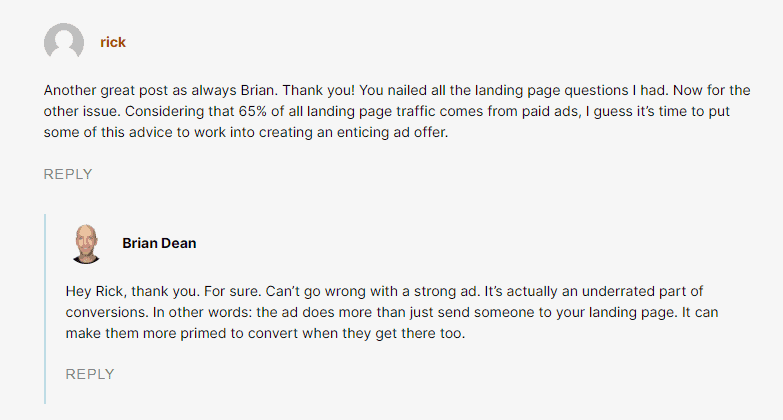
Here are some B2B blogging engagement tactics to encourage readers to interact with your company blog:
- Enable comments: This is like opening a two-way street for conversation. It builds a community, encourages dialogue, and shows your readers you value their input. For instance, a reader might ask about a feature of your software – your detailed response could turn curiosity into a lead.
- Social sharing: This is digital word-of-mouth and it amplifies your reach, getting your insightful blog posts into the hands of potential leads. Imagine a reader sharing your infographic on LinkedIn, catching the eye of a decision-maker in need of your services.
- Conduct surveys or polls: The results from these will guide you to what your readers crave. For example, a poll asking readers which of your business solutions they’d like to learn more about can shape your next post, ensuring it hits the mark and increasing the chances of turning them into leads.
You can also host webinars or live Q&A sessions, letting readers engage with you and industry experts in real time. Thus, facilitating knowledge sharing and building credibility within your niche.
9. Utilize Engaging Visuals
It’s not all about the written text. Make your blog articles even more irresistible to your B2B clients and embrace the power of engaging visuals.
But not just any photos. Each image needs to speak to your professional-oriented audience. You’ll need to integrate graphs, statistics, data sheets, infographics, and other data-driven visuals.
For decision-makers, numbers aren’t just figures; they’re the lens through which they view business choices. Show them how your solution can boost efficiency, cut costs, or increase ROI. Speak their language to make your case.
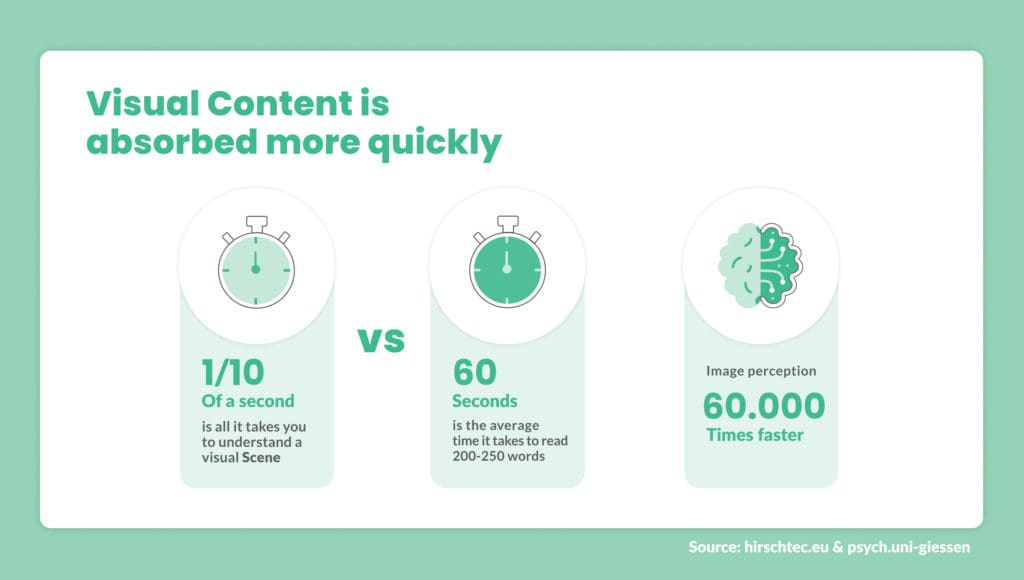
Now, you might be thinking, ‘This is going to take a lot of resources and time to put together’. Not really.
You don’t have to be a graphic designer to create stunning visuals. Thanks to user-friendly platforms like Canva and Midjourney on Discord, anyone can have eye-catching graphics and infographics without breaking the bank.
Additionally, you can utilize any statistical data derived from the services you’ve provided to your clients. It’ll highlight your performance and make the information more digestible.
More than making your blogs memorable, visuals are beneficial for those who don’t have minutes to spare to read your whole blog. So, get creative, experiment with different visuals, and make your blog stand out from the competition.
10. Collaborate With Experts
B2B blogging is not just about what you or your writer have to say, but also about the valuable perspectives you’ll bring in from others. Thus, collaborating with experts, both inside and outside of your organization, will take your blog articles to new heights in making your blog more trustworthy in the eyes of professionals and entrepreneurs.
Leveraging the expertise and reputation of collaborators enhances the value of your blog content. Plus, providing fresh perspectives makes your content engaging and diverse compared to other blogs.
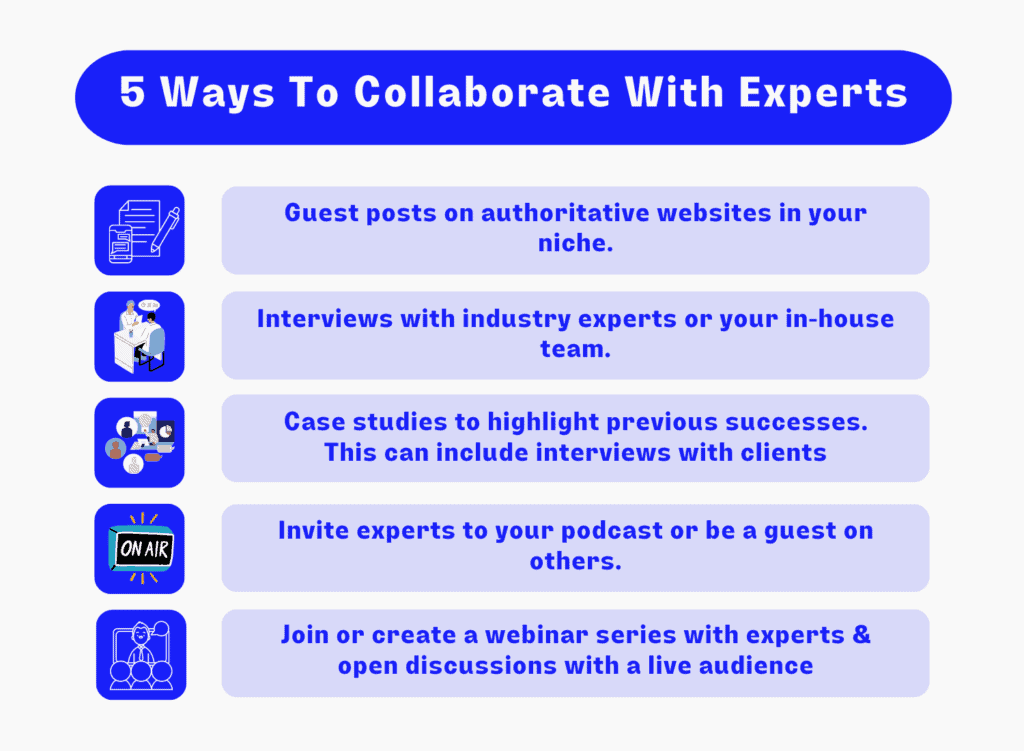
For example, conduct interviews with members of your product development team for an upcoming software launch. Your target buyers, like software engineers, will appreciate hearing insider information from a trusted source, rather than just seeing it in a typical sales advertisement.
Other than that, partner with external organizations like industry influencers or complementary businesses. You can interview a renowned expert in your field and feature their insights in a new blog post. This not only grabs the reader’s attention but also positions your company as a thought leader by association.
11. Include A Clear Call-To-Action (CTA)
A well-placed CTA guides your readers, tells them what to do next, and transforms casual browsers into active participants. It gets better. It can also drive conversions, generate leads, and boost your bottom line. Take a look at some examples below.
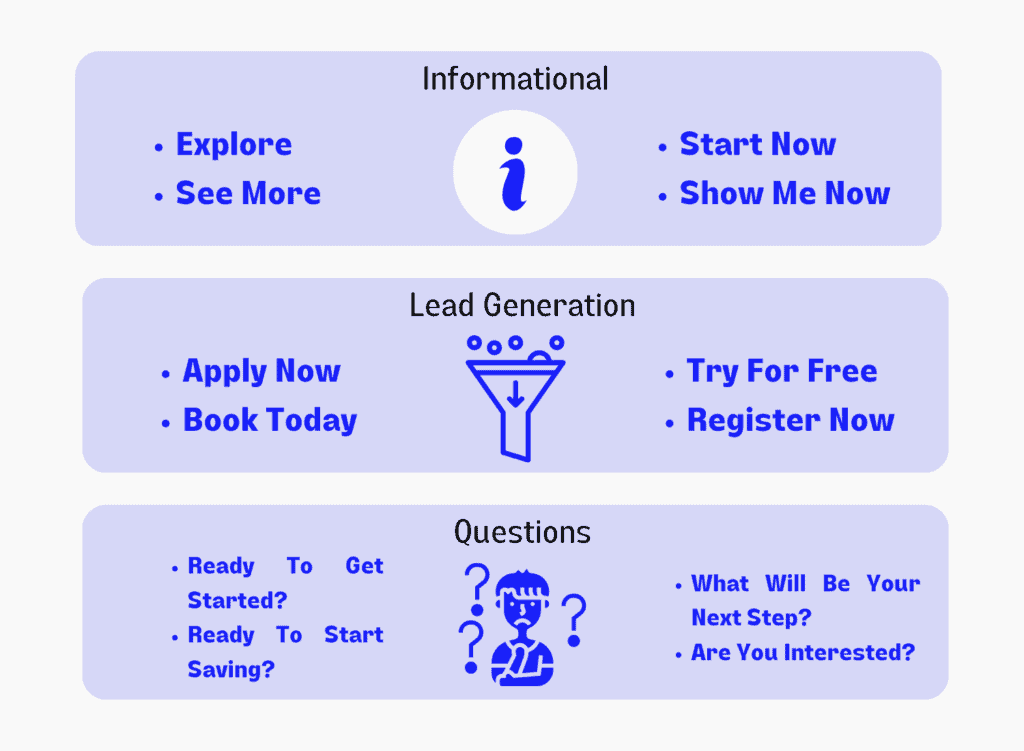
To make the most of your CTA, make it clear and compelling. Use action-oriented language to entice your audience to act now.
Place it strategically within your blog post, preferably near the end or at a natural break in the content. This ensures that readers already know your offer’s value before you nudge them toward a partnership with your company.
However, be sure that your CTA aligns closely with the topic you discussed in the blog post. Whether it’s directing them to a relevant service page or enticing them to request a product demo, the CTA should seamlessly connect the dots between your content and your business offerings.
Lastly, implement our number 1 rule here when it comes to CTA, don’t make it sound too promotional. Hard selling can just push them away.
12. Promote Your B2B Company Blog
Creating relevant and valuable content is just the beginning; you also need to get the word out about your B2B blog to make a real impact. Here are some tactics to help your marketing team promote your blog to professionals, managers, or even business owners:
- Utilize social media marketing: Share your blog posts on social media platforms that your target audience frequents like LinkedIn. That’s where the decision-makers are.
- Collaborate with influencers: We’re talking about working with other entrepreneurs, executives, keynote speakers, or thought leaders in your niche. You should also take advantage of guest blogging opportunities. Publishing a blog post on authoritative websites boosts the awareness of your blogging page and increases your credibility.
- Use email marketing: Regularly send out newsletters to your email list featuring your latest blog article. Personalize your emails and segment your subscribers to deliver tailored content that meets their interests and needs.
- Be active in your community: Participate in industry forums, LinkedIn groups, and online communities where your target audience hangs out.
Remember, promotion is an ongoing process. It doesn’t just take a week or a few months. Consistently share and promote your blog posts to ensure maximum visibility and engagement. To give you an extra nudge, consider the statistics in the next section.
What’s The Rundown On B2B Blogs?
Still on the fence? Let’s dive into some hard-hitting B2B statistics to downright convince you to kickstart your B2B blog.
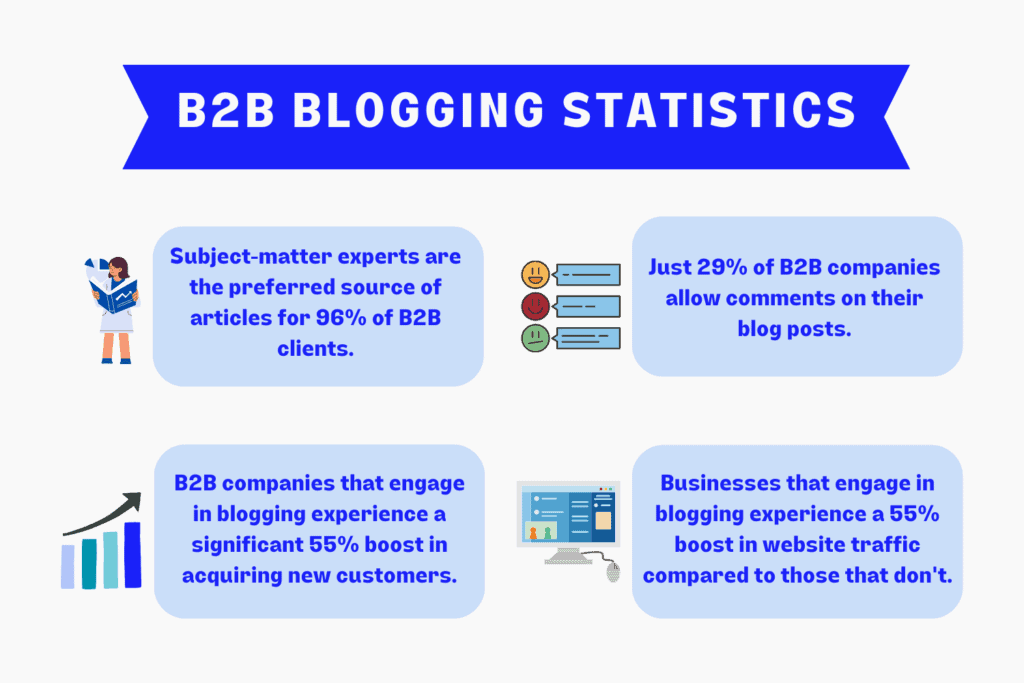
With that, let’s jump into some writing techniques. They’ll complement your B2B blogging best practices to ensure that all elements of your platform produce the best results to garner the attention of your clients.
5 Tactics To Remember When Writing A Blog Post
Master the art of blog post writing with these 5 vital tactics. Enhance your skills, captivate readers, and make the most of your writing team’s capacity for creating engaging and impactful content.
A. Craft An Impactful Headline
Don’t let your blog post be known for clickbait headlines. A poorly written or irrelevant headline will impact your reader engagement and cause higher bounce rates, affecting your SEO results.
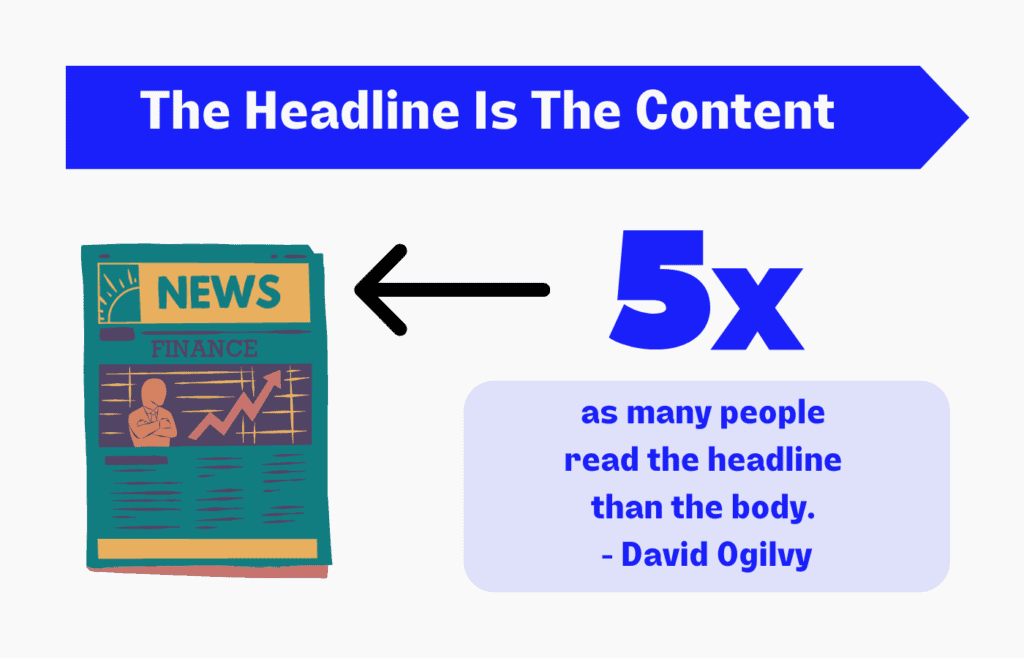
Focus on including target search terms and placing the primary search term early in the headline. It’ll help your headline to communicate what readers will learn. In addition, you should take advantage of modifiers like “2020,” “Best,” or “Guide” to add appeal.
Here are some other techniques to guide you:
- Make use of the top 10 websites ranking on page 1 of SERP.
- Utilize tools like Ahrefs for metrics like organic search traffic.
- Find powerful words you could incorporate in your title.
- If it’s possible and if it makes sense, front load the target search term.
- Try to keep your headline between 55 to 59 characters only.
- Add your flare in the title and not just copy what others are already using.
Also, some writers are very skillful when it comes to making eye-catching headlines. So, if you have that one writer, utilize his or her special skill. With the right headline, you’ll captivate your readers, improve your SEO, and ensure a successful publishing experience.
B. Utilize Headings & Subheadings
Headings and subheadings provide readers and search engines with a clear outline of your main points.
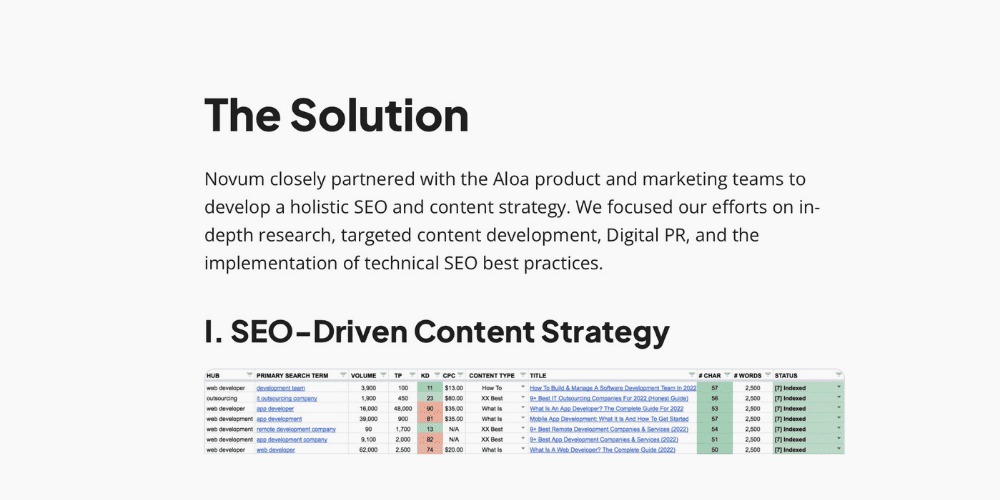
They break up your content, make it more reader-friendly, and help Google understand the topic of your article.
Additionally, you should incorporate your primary search term in an H2 heading and include secondary target search terms in the remaining subheadings whenever possible.
However, don’t overdo it. Strive for a balance that avoids stuffing search terms, especially since you’ll also be using your primary search term in the body of your article.
C. Add Internal Links
Internal links boost the user experience and strengthen your on-page SEO.
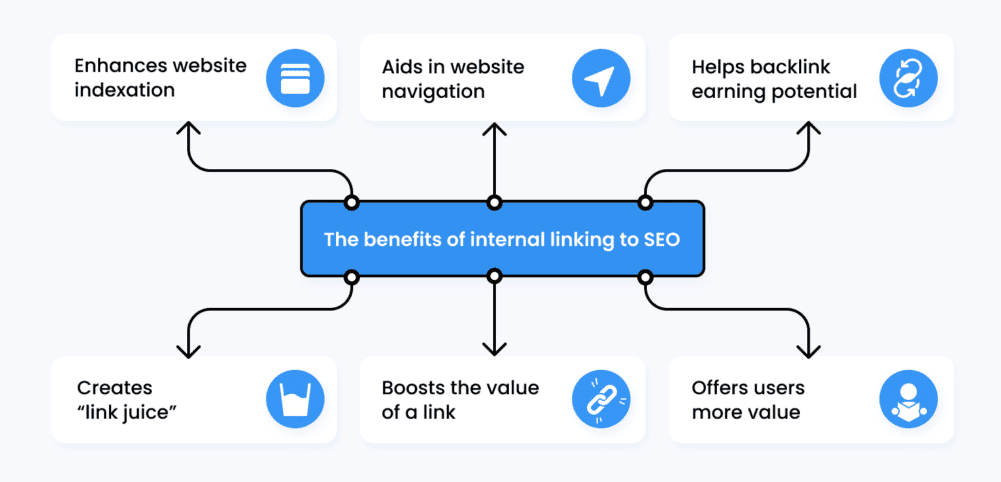
Here’s an example: Let’s say you’re managing a financial technology (fintech) company. You’ve just published a post about the latest advancements in AI for financial services. Within this post, you could incorporate internal links to your other articles like “How We Leverage AI In Our Financial Software” or “Maximizing Efficiency with AI in Portfolio Management.”
So, what does this do for you and your audience?
These internal links provide additional valuable information and make navigation to related content on your website easier. Thus, enhancing their user experience and boosting their engagement with your blog.
For Google’s crawlers, these links help them understand your website’s structure and the relationships between your content. This can boost your search rankings.
D. Add External Links
Enhance the value of your B2B blog post by incorporating external or outbound links to reputable websites. These links provide readers with additional resources and support your content’s credibility.
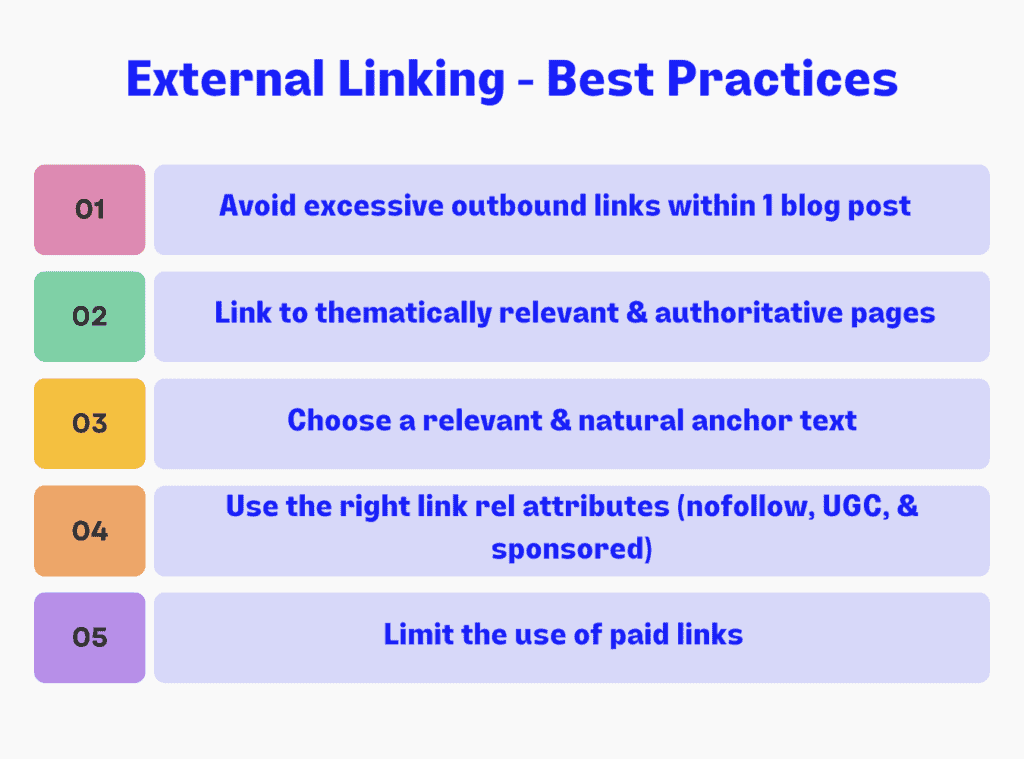
For example, if you’re discussing the benefits of email marketing, include a link to a renowned marketing blog that offers in-depth insights or further research on the topic. It could also initiate a connection between you and that authoritative website so you can build collaboration opportunities.
Moreover, it shows your clients and search engines that you’ve thoroughly researched your topic and are providing valuable information. So, push your content marketing team’s capacity to write engaging content, publish it with strategic links, and cultivate a reputable presence in your industry.
E. Write A Compelling Meta Description
A compelling meta description serves as a concise preview of your blog post’s value, enticing readers to click through. For example, if your blog post is about “time management techniques for busy professionals,” a captivating meta description could be:
“Discover effective time management strategies for busy professionals to boost productivity and reclaim control of your schedule. Master the art of prioritization and achieve work-life balance.”

You should also aim for a meta description of 140-160 characters, incorporating the main search term and intriguing language. This improves your chances of driving more clicks to your blog post.
How To Get Started On Your B2B Blog
Starting a B2B blog can be a daunting task, but here’s something to ease your worries: A quick overview of what you should do.
- Know Your Audience: Understand who you’re writing for. Are they industry leaders? Tech-savvy professionals? Tailor your content to their needs and interests.
- Set Clear Goals: Are you aiming to generate leads? Establish thought leadership? Define your goals to guide your content strategy.
- Create Valuable Content: Provide numbers, data, and practical advice that your audience can’t find anywhere else. Be the expert they turn to for information.
- Optimize for SEO: Identify industry-related search terms and optimize your content accordingly.
- Engage with Your Readers: Encourage comments, respond to feedback, and create a sense of community among the professionals you’re targeting, increasing the chances of them turning into leads.
Intricately woven within those steps are the B2B blog best practices. They’ll help position your blog for long-term success and won’t render your resources pointless.
Be competitive in your B2B niche and start applying these techniques. However, don’t forget to evaluate their impact on your blog’s performance and make necessary adjustments along the way.
So, how will you ensure your B2B blog stands out amidst the noise in the blogging world?
Well, Novum’s here. Our content creation process covers everything from ideation to ready-to-rank articles. That approach results in an increase in monthly traffic value for our clients. So, don’t wait any longer, and schedule a call now.

